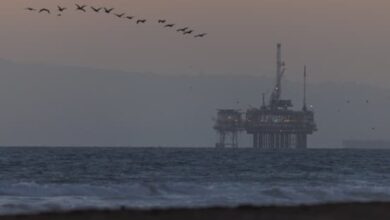from the tent city to the war zone in Rafah
In early May, the southern Gazan city of Rafah was bustling with more than 1 million displaced people. Now, most of the tents are gone and the remaining Palestinians in Rafah are facing at least five Israeli combat brigades on the ground.
By Tuesday, Israeli military vehicles were approaching the central Awda roundabout as they continued their attack; by Wednesday, Israeli forces declared “tactical” control of the Gaza-Egypt border along the edge of the city. A military official said that would allow Israel to “cut off the oxygen pipeline” to Egypt that Israel says the Palestinian militant group Hamas has used to supply and rearm.
Israel’s campaign against Hamas has transformed the city multiple times this month. Satellite images showed tents disappearing and several buildings hit by air strikes as Israel attacked what it sees as Hamas’s last stronghold.
The attack came despite warnings from Israel’s allies not to go ahead because of the human toll on Palestinians in the crowded area, who have endured nearly eight months of brutal conflict.
At least one million Palestinians have left Rafah in recent weeks to flee increasing Israeli attacks. Suze van Meegen, head of Gaza operations for the Norwegian Refugee Council, said the roads north were filled with desperate people seeking refuge after another round of forced displacement.
“Many cars ran out of fuel, so people had to push their carts filled with belongings out,” she said. “Those still in the south are doing all they can to move north from Rafah.”
Van Meegen this week described Rafah as “now consisting of three completely different worlds: the east is an archetypal war zone, the middle is a ghost town, and the west is a dense mass of people living in bad conditions”.

Abdul Rahman Shaath, a resident of Tal as-Sultan in northwest Rafah, said that after Israeli tanks reached the town center, “many families were stuck in the area unable to move. . . [The Israeli military has] also destroy all buildings east of Rafah.”
“We can’t see any buildings on the horizon in that direction anymore.”
IDF chief spokesman Daniel Hagari said Tuesday that Israeli is operating “in a more precise, safer and sometimes slower manner” than previous operations elsewhere in the strip.
But there were still mass casualties. At the weekend, an Israeli airstrike targeted two senior Hamas commanders in the northwestern Tal as-Sultan area killing about 45 people. The Israel Defense Forces said they were investigating the cause of the massive fire that ripped through the makeshift camp.

The attack, which van Meegen said took place near a United Nations building, shattered any remaining sense of security even for those who had fled on Israeli instructions to al-Mawasi, an already overcrowded narrow coastal strip west of Rafah, with no infrastructure, drinking water, toilets or sewage system.
Despite the harsh conditions, van Meegen said, “before this area had a feeling of protection; it feels quite far from the worst of the violence.
“But night and day we heard artillery and explosions, which created clouds of smoke in the sky that were visible from the coast for several hours.”
According to Palestinian health authorities, Israel’s attack in Gaza has killed more than 36,000 people. According to the Israeli government, Israel launched a campaign to respond to the cross-border attack on October 7 by Hamas, which left 1,200 people dead and 250 others taken hostage.


While some displaced families moved from Rafah to al-Mawasi, many others headed further north to the cities of Khan Younis and Deir al Balah.
Van Meegen said she saw “a large number of people on the street with all their belongings moving north.” “The roads are very congested with people walking or riding donkey carts and bicycles,” she added.
But many people, exhausted and having been displaced multiple times, say they have no other choice.
“Where can we go?” asked Ibrahim Hamad, who evacuated from northern Gaza to Rafah. “There is no vacancy anywhere and no safe space. Israel is pushing us out to sea, but the sand will not produce food or water for hundreds of thousands of people.”

Last week, Israeli troops moved through the eastern al-Shaboura refugee camp in Rafah, engaging Hamas militants and attempting to eliminate weapons and missile caches.
Israeli officials say the overall goal is to “destroy” the rebel group’s last four remaining battalions in the territory and rescue Israeli hostages they say are still being held in the Rafah area. .
Since the start of the war, Rafah has been the main base of humanitarian operations in Gaza, but the latest attack has further weakened the efforts of aid agencies that were already severely constrained by controls. Tight Israeli control and months of war.
Van Meegen said fuel shortages mean the Norwegian Refugee Council’s fleet of cars has much reduced capacity: some vehicles have empty tanks.
Van Meegen said several aid agencies were moving to Deir al Balah in central Gaza and the need was great. “We hope more people will relocate there,” she said.
Since Israel entered southern Gaza, the important Rafah border crossing between Gaza and Egypt has been closed. Angered by Israel’s takeover of the border crossing, Egypt stopped allowing aid trucks through and only over the weekend resumed sending trucks to Gaza through the Kerem Shalom border crossing from Israel.
Nineteen international aid agencies warned this week that “as Israel steps up its attacks on Rafah. . . in fact, the humanitarian response is on the brink of collapse.”




